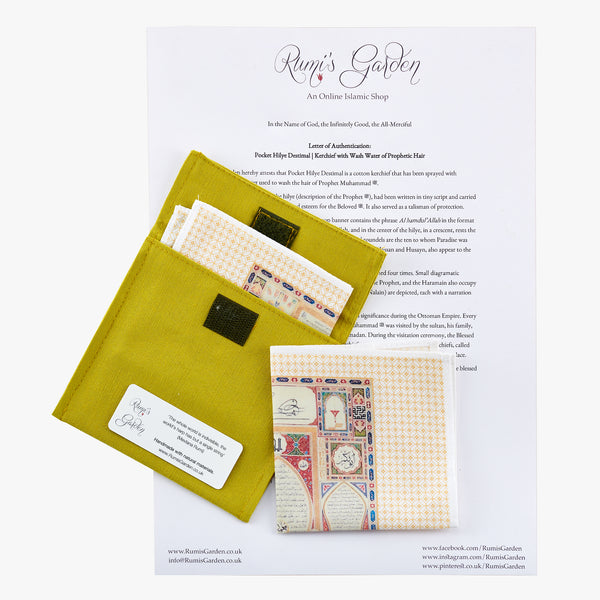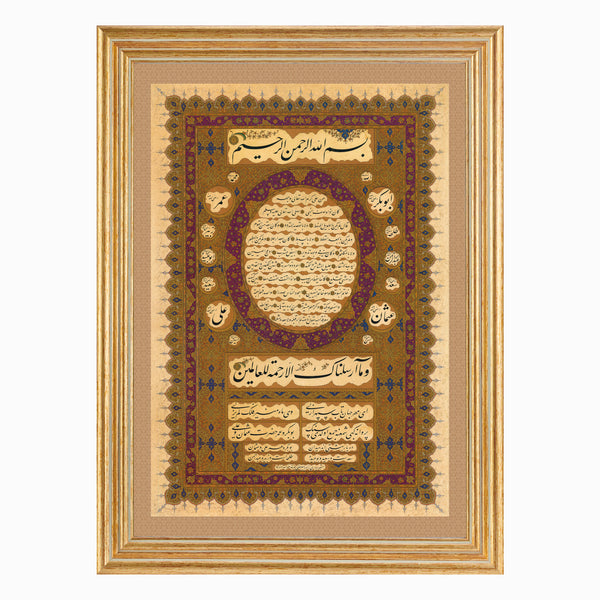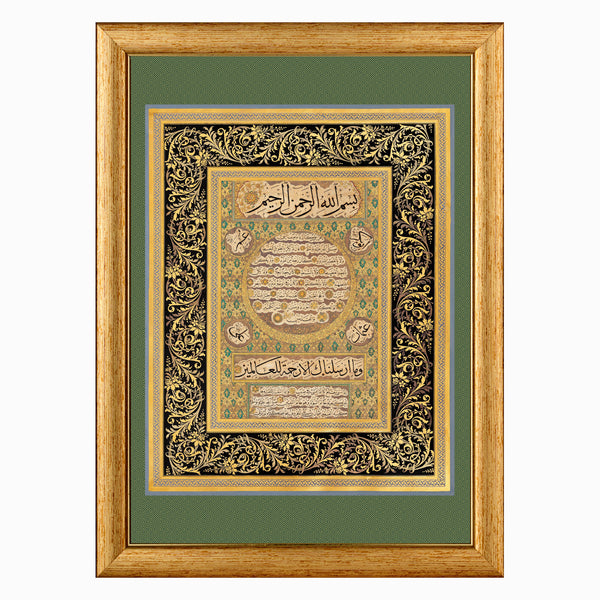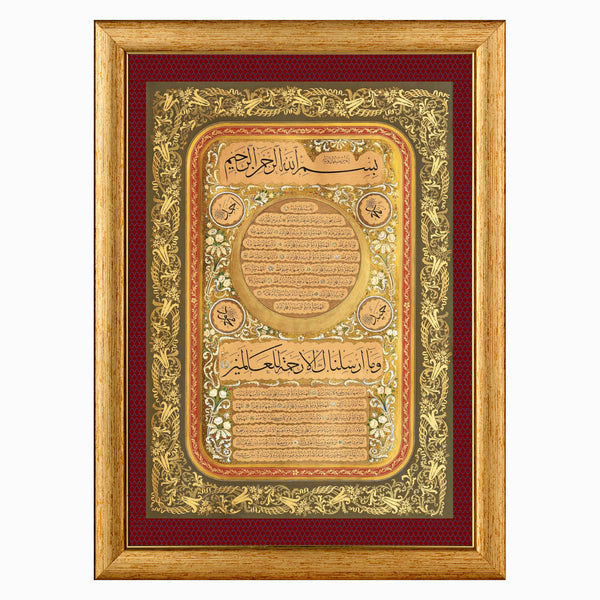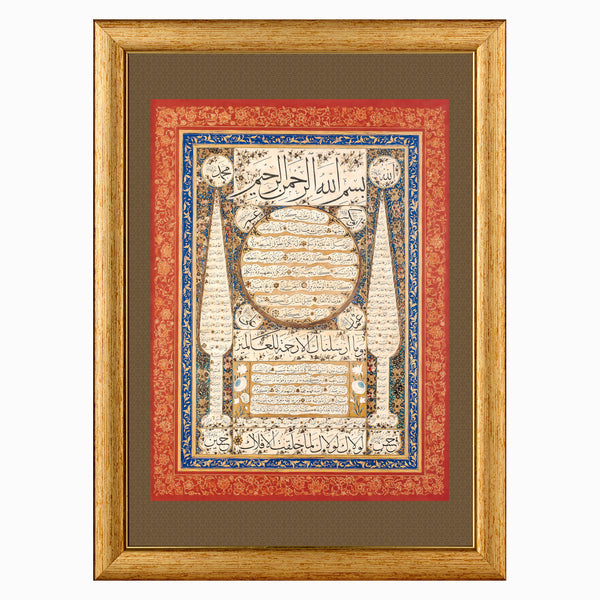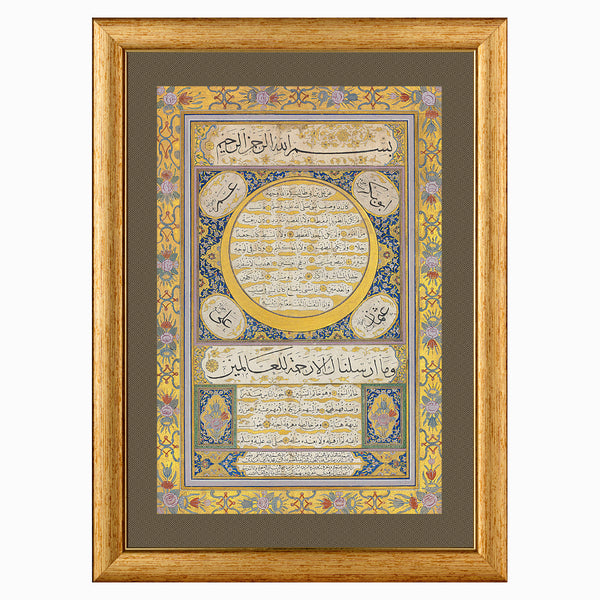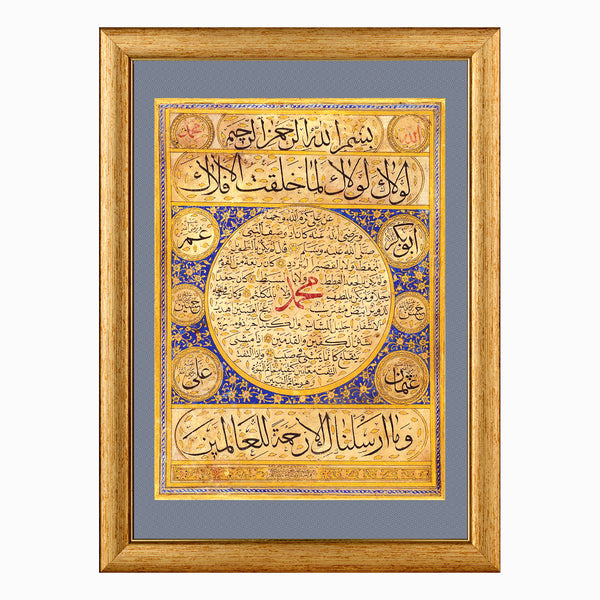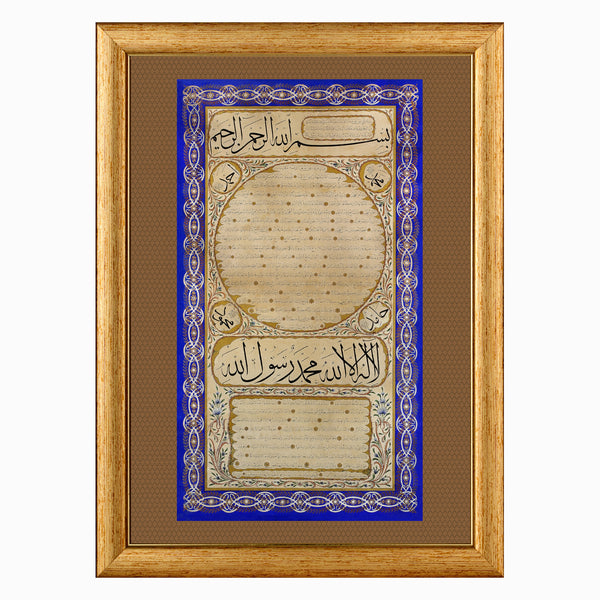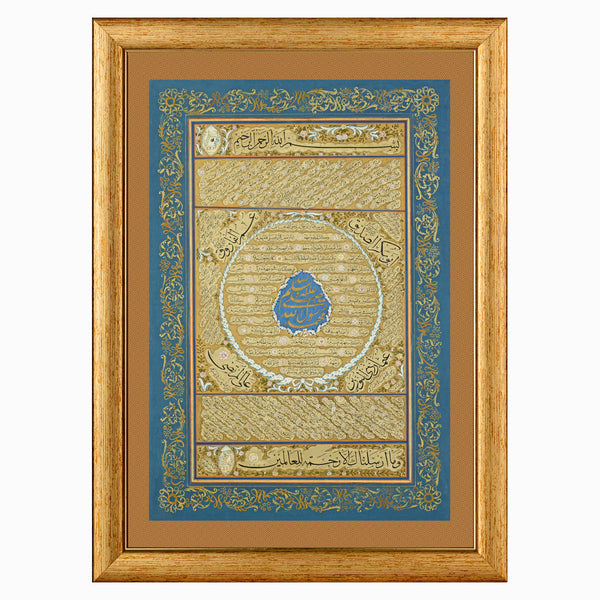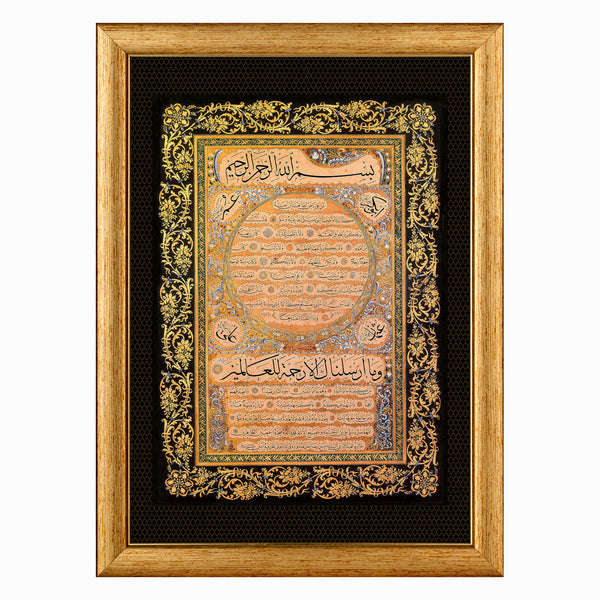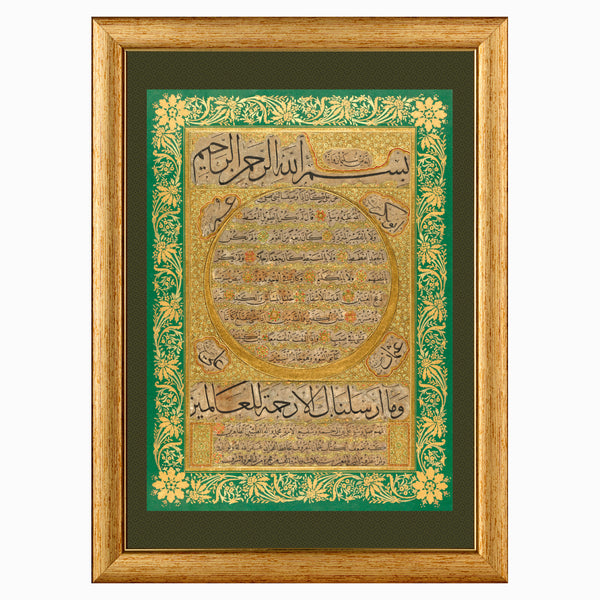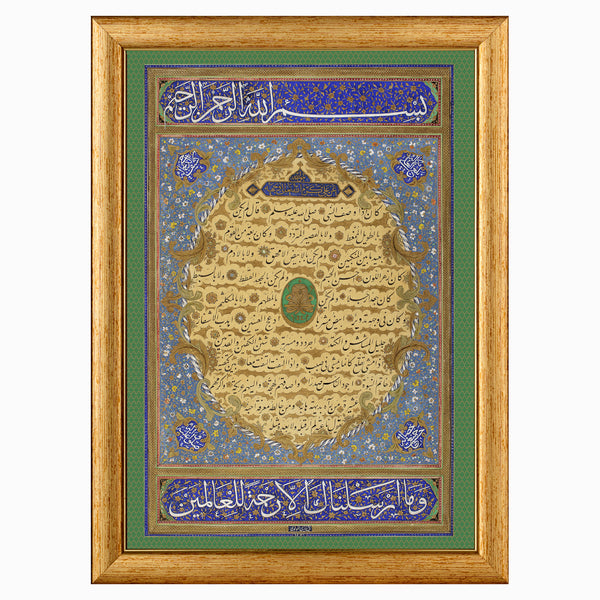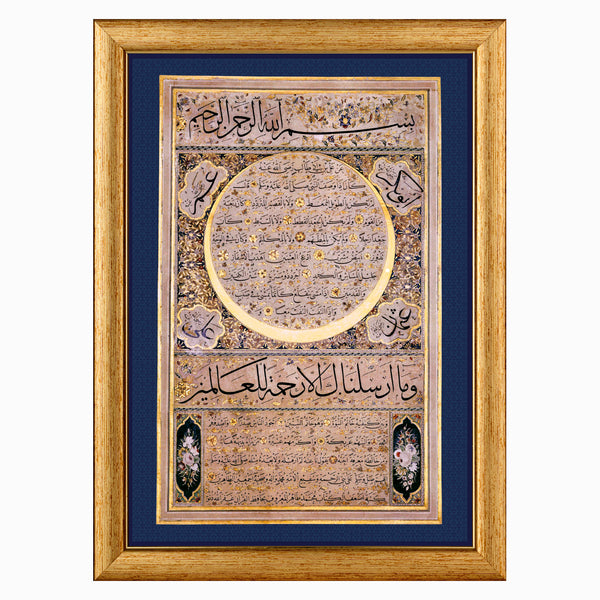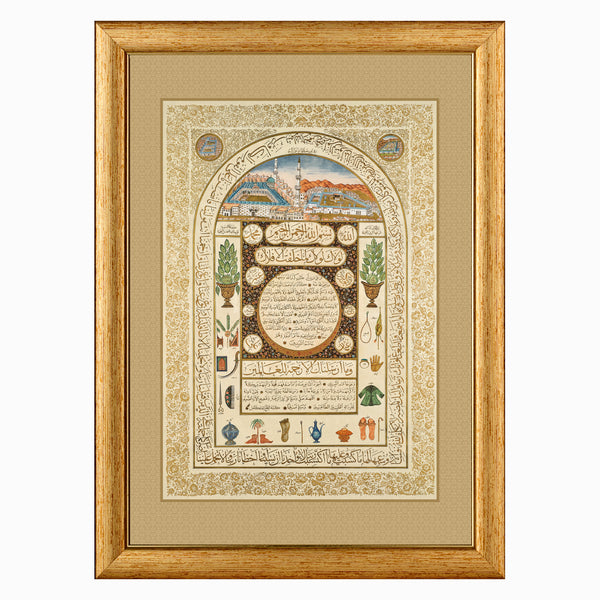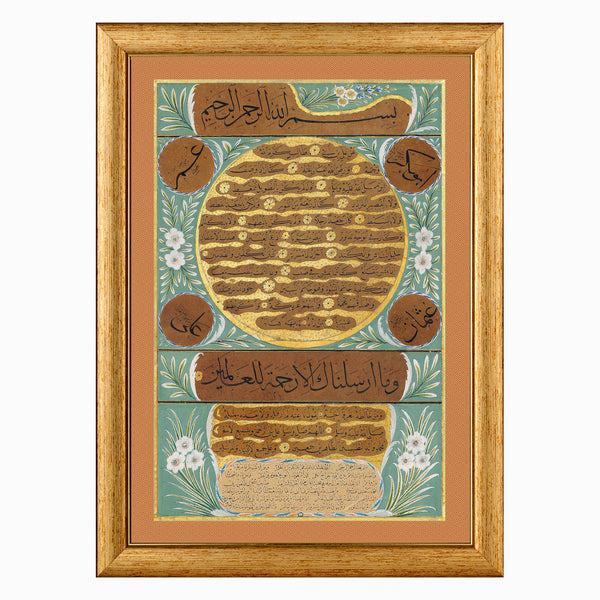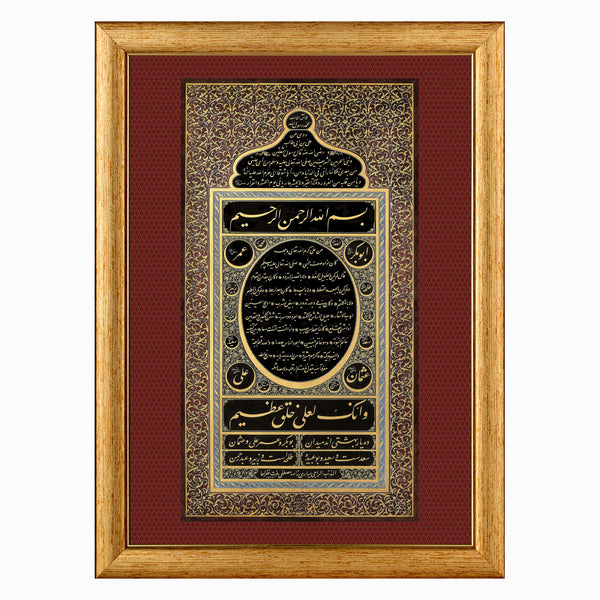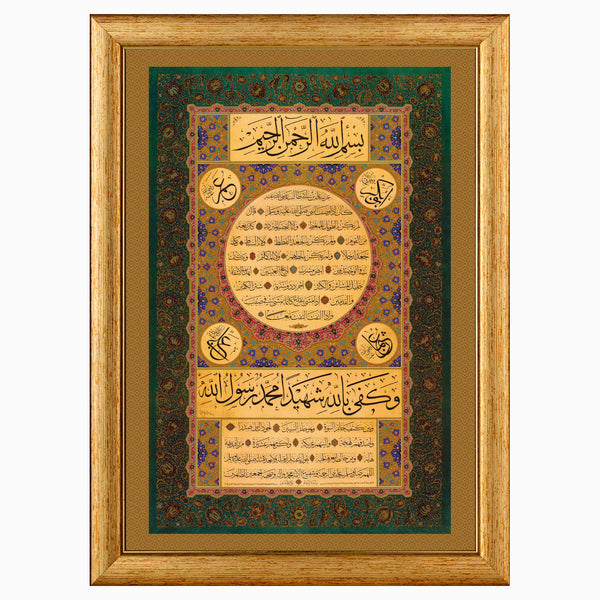Hilya | Description of Prophet Muhammad
Ottoman and Turkish hilya reproductions made to museum quality. The hilya (hilye/ حلية) is a description of the Prophet Muhammad ﷺ that would be written in beautiful Arabic calligraphy in order to be put up in homes, mosques, and businesses as a talisman for protection.
☾☾☾☾☾
What is the hilya/ hilye?
Hilye is the Osmanli (Ottoman) form of the Arabic word hilya (حلية), which according to the renowned calligrapher Mohammad Zakariya, has several meanings including physiognomy, natural disposition, likeness, depiction, characterization, and description. In the genre of literature and theology, hilye came to denote the physical, moral, behavioral, and spiritual qualities of Prophet Muhammad ﷺ often expressed in hadith narrations.
While writers and poets developed the hilye as a literary genre, it was the fate and the blessings of the Prophetic description to eventually become a decorative art form. Developed by Ottoman calligraphers and illuminators, the visual hilye became a vehicle for devotion and protection from trouble in this earthly abode and in the next life.
What is the history of the hilye?
During the lifetime of Prophet Muhammad ﷺ, his companions vividly described him in words allowing each of the faithful to carry him in their hearts and minds. These descriptions were transmitted by the collectors of canonical hadith. In the 9th century, Muhammad ibn 'Isa al-Tirmidhi, wrote al-Shama'il al-Muhammadiyya (The Muhammadan Traits), a book which gathered together these various narrated traditions. Another important source of hadith describing the Prophet is the Miskkat al Masabih, a collection of 5,945 hadith classified according to subject matter. The Mishkat al-Masabih originated with the work of Abu Muhammad al-Farra al-Baghawi and was finalised in its present form by Wali al-din al-Tibrizi.
In the 16th century, Hakani Mehmet Bey penned his well-known Masnavi poem entitled Hilye i-serif (often called Hilye-i Hakani). The poem tells the tale a dervish who presents the Caliph, Haroon al Rashid, with a piece of paper upon which is written a hilye, or description of the Seal of the Prophets ﷺ. In his sleep, the Caliph see the Prophet Muhammad in a dream and is told:
"O Harun! Since you are delighted by my hilye, and regard it well, and since you have presented the dervish with gifts, I shall now make you glad. God has commanded me that whoever sees my hilye shall become happy; whoever carries it, it shall become an amulet of Me; and when the day of Resurrection comes, Hell's fire shall be forbidden for them, and neither should they suffer in this world, or in the next..."
Hakani Mehmet Bey also presents a wisdom in his Masnavi when he says: "Our wise ancestors never refused any beggar who gave them a hilye".
The Ottomans carried these words close to heart and soon after, it became a tradition to carry pieces of paper inscribed with hilyes in order to obtain the Prophet's ﷺ intercession and baraka; these served as a tawidh or protective amulet.
In the year 1678, the calligrapher Hafiz Osman, who was known to have trained approximately fïfty students, including the Ottoman sultans Mustafa II and Ahmed III (1673-1736), was the first to write the hilye in the form of a levha, a circular calligraphic composition that became popular in the 18th and 19th centuries. These levha were intended to be read as well as to serve a decorative function and were most often framed and hung upon interior walls.
While the hilye may seem to be a simple devotional tool that aims to celebrate the Seal of Prophethood ﷺ, its function has a much more profound effect on the soul of one who contemplates it. Indeed, it is a testimony to the Muhammadan Substance which one Muslim thinker has described as:
The Muhammadan Substance is the love of God combined, by the nature of things, with contemplativeness and nobleness of character; as also with a sense of outward or practical values, such as the beauty of forms, and cleanliness, or the rules of propriety infused with generosity and dignity. The sense of outward things – although in no wise “vain” – stems in the final analysis from the emphasis on “discernment,” or from the element “Truth”; for one who discerns initially between the Absolute and the contingent, between necessary Being and possible being – and this is the very content of the Shahadah – will readily apply analogous discernments in the sphere of contingency. As for the sense of beauty, it is related to the mystery of Immanence.
An Excerpt from the Hilye-i Hakani by Hakani Mehmed Bey
All of the folk hereon agree,
That the Pride of the World was bright of blee,
Full sheen was the radiance of his face,
His cheeks were lustrous with lustre's grace.
One of heart with the rose was his face's hue;
Like the rose, unto ruddiness it drew.
Yeled his face in the light of delight,
'Twas the Chapter of Light of the dawn of light.
The scripture of beauty was that fair face;
The down on his cheek was the verse of grace.
Shamed by his visage bright as day,
Life's Fountain hid in the dark away.
Well may the comrades of joyance call:
'The sheen of his visage conquers all!
'Yon radiant face shone in the sky,
The light of the harem-feast on high.
The Portrait-painter of Nature gave
Thereto all beauty that man may have.
When the sweat upon that Sultan stood
He was forsoth like the rose bedewed.
What is the layout structure of the decorative hilye of the standard hilye?

The decorative hilye layout established by Hâfız Osman, which eventually became the standard, generally consists of six textual sections:
Section 1 is the Baş Makam (Place of Eminence). This first section of text is always devoted to the Basmalah (In the Name of God, the Infinitely Good, the Boundlessly Merciful) or the Quranic verse 'It is from Solomon, and it is in the Name of God, the All-Merciful the Meed-Giver of Mercy.' (27: 30).
Section 2 is the Göbek (Belly). This is a central circular that contains all or the first part of the main text about the Prophet Muhammad‟s ﷺ appearance and character, based on hadith, the most well-known account being from Imam Al-Tirmidhi's al-Shama'il al-Muhammadiyya. This part of the hilye may be circular, oval, or square. Imam al-Tirmidhi regarded the hadith most commonly referenced in the hilye as being of relatively high quality (hasan gharib). Dr. Alan Godlas translates it as: "When 'Ali ibn Abi Talib [may Allah be pleased with him] described the Prophet (ﷺ) he would say: 'He was not tall to the extent of being lanky, nor was he short to the extent of being compact, and he was of medium height among people. The curliness of his hair was not to extent of being frizzy, nor was his hair straight, but it was in between. He did not have a large head, nor a small head; and his face was round and a blended-white color, his eyes were dark black, his eyelashes were long. He was big-boned and broad shouldered; his body hair was well-placed, and he had a masrubah, his palms were thick as were his feet [thick]. When he walked he walked briskly; he leaned forward as if he was walking on a decline. And when he turned his head, his body turned as well; between his two shoulders was the seal of Prophethood, and he was the seal of the Prophets. He was the most generous of people, being open-hearted. He was the most truthful of people in speech, the softest of them in nature, and the most noble of them in his [family] relations. Whoever saw him for the first time would fear him; and whoever got to know him, loved him. The one who tried to describe him would say: 'I have not seen anyone who resembles him (ﷺ), either before him or after him."
Section 3 The hilâl, or crescent encircles the göbek, with its thick middle part at the bottom. It is an optional section that artists chose to insert into the hilya.
Section 4 is the Köşeler (corners). The göbek is surrounded by four roundels which in which the names of the çiharyâr (four companions) are scripted: Abu Bakr, Umar, Uthman, and, Ali. In some hilye models, the hilye models various titles of the Prophet Muhammad ﷺ, the Divine Names or the ten companions are used.
Section 5 is the Âyet or Kuşak (verse or belt). This section which rests below the göbek and often contains a Quranic verse about the Prophet Muhammad ﷺ such as: We sent thee not save as a mercy for the worlds [21:07]
Section 6 is the Etek (skirt). This part of the hilye often contains the conclusion of the text begun in the göbek, a short prayer for the Prophet, and the signature of the calligrapher.

The decorative hilye layout established by Hâfız Osman, which eventually became the standard, generally consists of six textual sections:
Section 1 is the Baş Makam (Place of Eminence). This first section of text is always devoted to the Basmalah (In the Name of God, the Infinitely Good, the Boundlessly Merciful) or the Quranic verse 'It is from Solomon, and it is in the Name of God, the All-Merciful the Meed-Giver of Mercy.' (27: 30).
Section 2 is the Göbek (Belly). This is a central circular that contains all or the first part of the main text about the Prophet Muhammad‟s ﷺ appearance and character, based on hadith, the most well-known account being from Imam Al-Tirmidhi's al-Shama'il al-Muhammadiyya. This part of the hilye may be circular, oval, or square. Imam al-Tirmidhi regarded the hadith most commonly referenced in the hilye as being of relatively high quality (hasan gharib). Dr. Alan Godlas translates it as: "When 'Ali ibn Abi Talib [may Allah be pleased with him] described the Prophet (ﷺ) he would say: 'He was not tall to the extent of being lanky, nor was he short to the extent of being compact, and he was of medium height among people. The curliness of his hair was not to extent of being frizzy, nor was his hair straight, but it was in between. He did not have a large head, nor a small head; and his face was round and a blended-white color, his eyes were dark black, his eyelashes were long. He was big-boned and broad shouldered; his body hair was well-placed, and he had a masrubah, his palms were thick as were his feet [thick]. When he walked he walked briskly; he leaned forward as if he was walking on a decline. And when he turned his head, his body turned as well; between his two shoulders was the seal of Prophethood, and he was the seal of the Prophets. He was the most generous of people, being open-hearted. He was the most truthful of people in speech, the softest of them in nature, and the most noble of them in his [family] relations. Whoever saw him for the first time would fear him; and whoever got to know him, loved him. The one who tried to describe him would say: 'I have not seen anyone who resembles him (ﷺ), either before him or after him."
Section 3 The hilâl, or crescent encircles the göbek, with its thick middle part at the bottom. It is an optional section that artists chose to insert into the hilya.
Section 4 is the Köşeler (corners). The göbek is surrounded by four roundels which in which the names of the çiharyâr (four companions) are scripted: Abu Bakr, Umar, Uthman, and, Ali. In some hilye models, the hilye models various titles of the Prophet Muhammad ﷺ, the Divine Names or the ten companions are used.
Section 5 is the Âyet or Kuşak (verse or belt). This section which rests below the göbek and often contains a Quranic verse about the Prophet Muhammad ﷺ such as: We sent thee not save as a mercy for the worlds [21:07]
Section 6 is the Etek (skirt). This part of the hilye often contains the conclusion of the text begun in the göbek, a short prayer for the Prophet, and the signature of the calligrapher.

